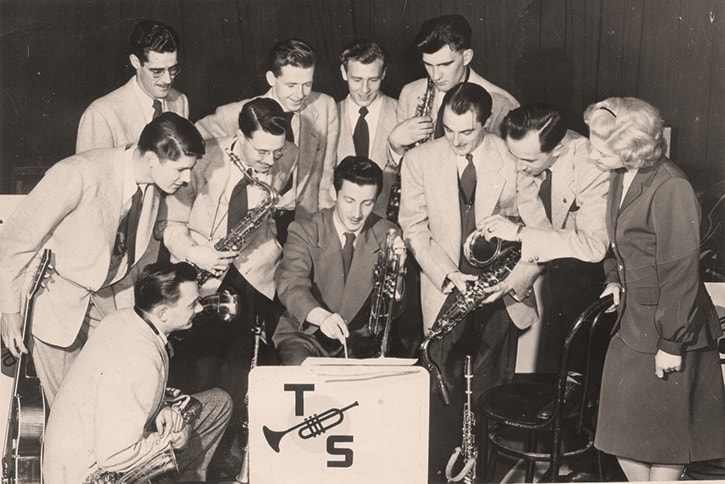Music is an inherent characteristic of White Rock history.
A large dance hall, the Auditorium, was thriving on the waterfront long before the first civic building raised its modest head.
Local resident Tom Symington was too young to take part, but he did make his mark on its best remembered successors, the Blue Moon and the Palladium.
“That was a great place, that Blue Moon,” he fondly remembers.
By the late 1940s, Tom and his 10-piece orchestra were playing a regular gig at the Palladium on East Beach, touted as Canada’s finest dance floor.
“When I brought the band down to the Palladium, Guy Graham, the owner, insisted on having union bands. I was already in the union, but all the other guys had to join.”
This was not Tom’s introduction to the seaside resort. His parents, Tom and Margaret Symington, purchased their cottage on Gordon Avenue with the quaint name of “Toot’n cum in” about the time of Tom Jr.’s birth in 1921. This building still stands, along with a tree Tom planted as a boy.
During Tom’s childhood, the family lived in the grounds of Essendale Hospital, where his father was employed as an engineer and Tom and his sister, Peggy, attended the one-room school.
Aspiring to play the trumpet, Tom settled for a cornet until he could buy his preferred instrument with the profits of a paper route. He joined several boys’ bands, and played at dances for a dollar an hour, big money in those days.
Shortly before he finished high school, his father died and plans for college were out of the question on his mother’s $25-a-month pension. He landed a job with the Royal Bank and began playing with a local band in New Westminster. It wasn’t long before the band became known as the Tommy Symington Orchestra, at the insistence of the other members – a tall order for a teenager.
Tom recalled, “I didn’t care about White Rock then. I was working in Vancouver, and thought I’d never be down there again. About five years later, I’m crying my eyes out. The cottage was sold for only $400, and my mother could use the money.”
When war broke out, he tried to enlist but, being underage, he had to settle for the reserves. Finally, in 1942, despite a bad chest, he was accepted for active service, assigned to the Royal Rifles of Canada, ironically, because the regiment needed musicians.
He tried hard to get into the thick of things, even taking commando training but was medically discharged before he saw action.
After the war, Tom resumed his music career with the big band for a few years, then gravitated to smaller groups. It was less work, especially with a day job. The recollection of the Flame Supper Club, where he played for seven years, and the Booze Cruises brought a glint to his eye.
“That was one of the greatest rides. The boat left every Wednesday and Saturday nights from the bottom of Main Street, right down on the waterfront. The boat was the Lady Alexandra. We’d get on at 7, and play until we got up coast to Bowen Island where we stopped.
“We had to carry our instruments up to an outdoor dance hall, play for two or three hours, then back to the boat. Every night on the trip back, the captain would have us play ‘Aloha.’ The deck was pretty colourful; it was really good.”
In 1960, Tom and his wife, Sheila, began the move to White Rock, buying a summer house on Buena Vista Avenue. Music still played a major role in his life.
“I had a band down in the Dolphins Restaurant. A friend of mine, Keith Sturrock, had that place beside the pier. He lost his shirt because he was 20 years too soon. He brought in fish from the Gulf Islands and had a real good business going. But he had a bar, and the kids would break in and steal the booze. In the winter time, there weren’t enough customers.”
Later, Tom formed an eight-piece band that played at White Rock’s Upper Town Centre hall.
“Don Goodwin and I decided to get a bunch of old guys together. So, we dragged a bunch of guys who had played before to form a band playing stock arrangements. We had a lot of people coming in, but we couldn’t get a steady, long-term booking. Try and run a dance where you’ll be playing one night, and someone asks, ‘Are you playing here next Saturday?’ ‘We don’t know.’ We were all past our prime, but the people liked it.”
The walls of Tom’s music room are lined with posters reminiscent of former days. The ambience reflects the vitality of this ageless nonagenarian. Music power? On the other hand, Tom’s grandfather lived to 104, but was he a trumpet player?
The Peninsula’s best-known mother-and-son historians, Lorraine and Hugh Ellenwood, are dedicated to preserving history through the White Rock Museum & Archives. Call 604-541-2225, or email whiterockarchives@telus.net
